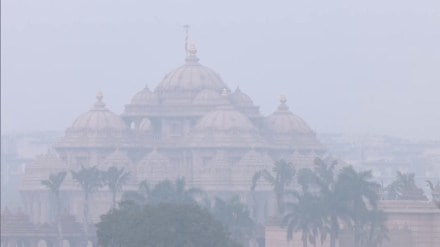Delhi’s air quality stayed in the “very poor” category on Monday morning, with the overall Air Quality Index (AQI) crossed 400 at 7:00 am. Out of the 38 pollution monitoring stations across the national capital, 14 showed “severe” pollution levels.
Wazirpur was the most polluted area with an AQI of 448, while Mandir Marg recorded the lowest at 333, which still falls under “very poor,” category, according to Central Pollution Control Board (CPCB) data.
Farm fires drop sharply
Farm fires in Punjab and Haryana have dropped sharply, now down to single digits. Because of this, their impact on Delhi’s PM2.5 levels has reduced a lot. Stubble-burning pollution, which had peaked at 22.4% on November 12, fell to just 2.66% on November 22. With almost no fresh fires reported on Sunday, experts expect this contribution to stay below 5% – much lower than in previous years.
Data from the Decision Support System also showed a 2.66% share from stubble burning on Saturday. There was no data for Friday, while Thursday saw a 2.88% contribution. The system predicts that this share will stay below 3% on Monday and Tuesday.
This year’s peak is not just lower – it also came later than usual. Last year, the highest single-day share was 35.1% on November 1. In both 2023 and 2022, it touched 35% on November 3. In 2021, the peak was much higher at 48%, recorded on November 6, according to a report by Hindustan Times.
Farm fire data from the Indian Agricultural Research Institute shows a sharp drop in burning incidents this year. Punjab reported just three fires on Sunday and nine on Saturday. Haryana recorded one fire on Sunday and 13 on Saturday.
From September 15 to November 23, Punjab logged 5,088 fires – less than half of last year’s 10,605. Haryana reported 617 fires in the same period, down from 1,263 last year. The institute tracks these fires from September 15 to November 30, which is the usual window for paddy stubble burning.
According to CPCB data at 7:00 am, several parts of Delhi recorded “severe” air quality. These include Anand Vihar (427), Ashok Vihar (421), Bawana (431), Burari Crossing (401), Jahangirpuri (437), Mundka (413), Narela (415), Nehru Nagar (407), Patparganj (401), Punjabi Bagh (412), Rohini (438), Sonia Vihar (407), Vivek Vihar (445) and Wazirpur (448).
Check area-wise AQI
| Location | Agency | AQI levels |
| Alipur, Delhi | DPCC | 412 |
| Anand Vihar, Delhi | DPCC | 442 |
| Ashok Vihar, Delhi | DPCC | 436 |
| Aya Nagar, Delhi | IMD | 355 |
| Bawana, Delhi | DPCC | 439 |
| Burari Crossing, Delhi | IMD | 433 |
| CRRI Mathura Road, Delhi | IMD | 374 |
| Chandni Chowk, Delhi | IITM | 389 |
| DTU, Delhi | CPCB | 444 |
| Dr. Karni Singh Shooting Range, Delhi | DPCC | 370 |
| Dwarka-Sector 8, Delhi | DPCC | 401 |
| IGI Airport (T3), Delhi | IMD | 349 |
| IHBAS, Dilshad Garden, Delhi | CPCB | 345 |
| ITO, Delhi | CPCB | 409 |
| Jahangirpuri, Delhi | DPCC | 455 |
| Jawaharlal Nehru Stadium, Delhi | DPCC | 391 |
| Lodhi Road, Delhi | IITM | 358 |
| Lodhi Road, Delhi | IMD | 353 |
| Major Dhyan Chand National Stadium, Delhi | DPCC | 346 |
| Mandir Marg, Delhi | DPCC | 333 |
| Mundka, Delhi | DPCC | 440 |
| NSIT Dwarka, Delhi | CPCB | 321 |
| Najafgarh, Delhi | DPCC | 359 |
| Narela, Delhi | DPCC | 433 |
| Nehru Nagar, Delhi | DPCC | 410 |
| North Campus, DU, Delhi | IMD | 405 |
| Okhla Phase-2, Delhi | DPCC | 377 |
| Patparganj, Delhi | DPCC | 412 |
| Punjabi Bagh, Delhi | DPCC | 423 |
| Pusa, Delhi | DPCC | 394 |
| Pusa, Delhi | IMD | 386 |
| R K Puram, Delhi | DPCC | 405 |
| Rohini, Delhi | DPCC | 458 |
| Shadipur, Delhi | CPCB | 377 |
| Sirifort, Delhi | CPCB | 380 |
| Sonia Vihar, Delhi | DPCC | 428 |
| Sri Aurobindo Marg, Delhi | DPCC | 338 |
| Vivek Vihar, Delhi | DPCC | 458 |
| Wazirpur, Delhi | DPCC | 448 |
Across other major Indian cities, air quality varied widely at 7 am. Chennai (51), Bengaluru (54) and Hyderabad (85) had “satisfactory” air. Pune (153), Mumbai (171), Patna (160) and Lucknow (195) were in the “moderate” range. Ahmedabad (208) and Jaipur (261) slipped into the “poor” category. Delhi, at 380, had “very poor” air – the worst among all listed cities.
According to the CPCB scale, an AQI of 0–50 is good, 51–100 satisfactory, 101–200 moderate, 201–300 poor, 301–400 very poor, and 401–500 severe.
CAQM changes GRAP rules
In view of the worsening pollution, the Commission for Air Quality Management (CAQM) has reshuffled the measures under the Graded Response Action Plan (GRAP). This means some actions that were earlier part of higher stages will now be taken earlier.
Work-from-home – earlier a GRAP 4 step – has now been moved to GRAP 3. Changing office timings, which was part of GRAP 3, is now included in GRAP 2. Steps like ensuring uninterrupted power supply, issuing Do’s and Don’ts, and improving traffic flow – earlier under GRAP 2 – have been shifted to GRAP 1.
Currently, GRAP 3 is active in Delhi. Under this level, non-essential construction and demolition activities are banned. Restrictions also apply to older vehicles, especially those below BS-IV norms. People have been asked to avoid going outdoors during early mornings and late evenings. Schools and institutions have been advised not to conduct sports or other outdoor physical activities.
